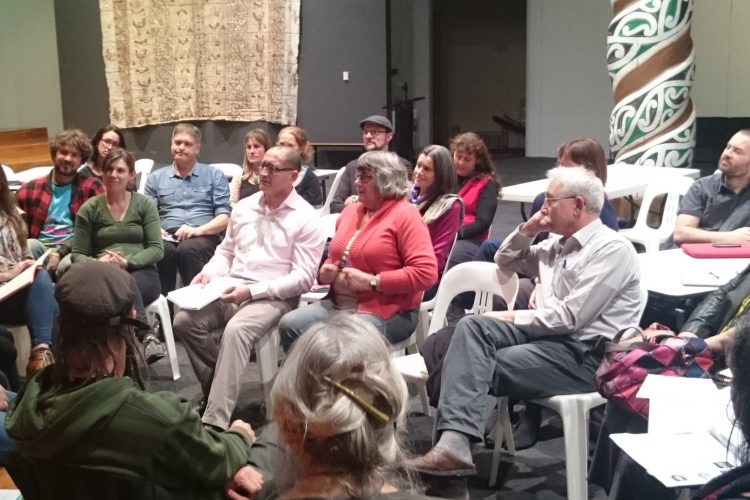
March 1st, 2021
Vulnerability and Courage in engaging with Cultural Sustainability
We are at our most powerful as a team when we work from our strengths, and support each other’s weaknesses. This requires vulnerability – it means we need to put our weaknesses on the table along with our strengths. Some leaders find this easier than others!
In leadership, vulnerability involves leading with all of yourself: knowing, and incorporating into your playbook, your own strengths and weaknesses. It also involves creating a space in which your team know that it’s OK to bring all of themselves too. This culture of vulnerability is an important part of fostering collective leadership in our organisations.
One area in which I have been trying to be more vulnerable is my ongoing journey as tauiwi (non-Māori) engaging with Te Tiriti. As a Pākehā, I have found that engagement with Te Tiriti is a journey that demands vulnerability. If I am to honour the process and honour the people – tūpuna as well as current colleagues and friends – then I must be real about my failings in the past, and the lessons I learn along the way.
And, of course, it’s bigger than me – I must also be real about the history of Te Tiriti, the role of the Crown, and the current landscape in which I work (education).
After defining vulnerability as “uncertainty, risk and emotional exposure,” Brené Brown goes on to say “…but vulnerability is not weakness; it’s our most accurate measure of courage.” As Susan Jeffers wrote, “feel the fear and do it anyway” – nowhere is this more applicable than emotional exposure, with our leadership and our engagement with real human beings.
I have found this ‘vulnerability/courage framework’ helpful in navigating my bicultural haerenga (journey), particularly when it comes to getting past ‘Pākehā paralysis’. When I feel overwhelmed with the scope of the task ahead, or with the perceived minefield of doing the wrong thing or saying the wrong thing (even writing this!), the answers lie in vulnerability.
If you’re reading this and you’re tauiwi (non-Māori), consider: where are you at in your bicultural journey as you lead in Aotearoa New Zealand? Do your team members and colleagues know where you’re at? Do the whānau in the communities you serve know where you’re at?
If you’re reading this and you’re Māori, consider: what would it look like for your team members to be actively engaging in their bicultural journeys? In what ways can you, as a leader, foster a culture of vulnerability in your team to better facilitate their engagement with their own journeys?
As leaders, we hope to inspire others; this depends on our journey being visible, not perfect.
“Inspiration,” according to Dr Selwyn Katene, “means being a clear example of what someone else can become… Inspirational leadership boils down to delivering on promises, communicating clearly and ‘taking the people with you’ on the journey.” Note that Dr Katene said “taking the people with you on the journey,” not “calling the people to join you at the destination that you’ve already reached”!
May your leadership inspire vulnerability in, and with, those whom you serve. And may that vulnerability empower you to take the people with you on the journey.
– Stephen McConnachie | Education Consultant, Think e-Learning | Leadership Consultant, Leadership Lab

March 1st, 2021
Vulnerability and Courage in engaging with Cultural Sustainability
We are at our most powerful as a team when we work from our strengths, and support each other’s weaknesses. This requires vulnerability – it means we need to put our weaknesses on the table along with our strengths. Some leaders find this easier than others!
In leadership, vulnerability involves leading with all of yourself: knowing, and incorporating into your playbook, your own strengths and weaknesses. It also involves creating a space in which your team know that it’s OK to bring all of themselves too. This culture of vulnerability is an important part of fostering collective leadership in our organisations.
One area in which I have been trying to be more vulnerable is my ongoing journey as tauiwi (non-Māori) engaging with Te Tiriti. As a Pākehā, I have found that engagement with Te Tiriti is a journey that demands vulnerability. If I am to honour the process and honour the people – tūpuna as well as current colleagues and friends – then I must be real about my failings in the past, and the lessons I learn along the way.
And, of course, it’s bigger than me – I must also be real about the history of Te Tiriti, the role of the Crown, and the current landscape in which I work (education).
After defining vulnerability as “uncertainty, risk and emotional exposure,” Brené Brown goes on to say “…but vulnerability is not weakness; it’s our most accurate measure of courage.” As Susan Jeffers wrote, “feel the fear and do it anyway” – nowhere is this more applicable than emotional exposure, with our leadership and our engagement with real human beings.
I have found this ‘vulnerability/courage framework’ helpful in navigating my bicultural haerenga (journey), particularly when it comes to getting past ‘Pākehā paralysis’. When I feel overwhelmed with the scope of the task ahead, or with the perceived minefield of doing the wrong thing or saying the wrong thing (even writing this!), the answers lie in vulnerability.
If you’re reading this and you’re tauiwi (non-Māori), consider: where are you at in your bicultural journey as you lead in Aotearoa New Zealand? Do your team members and colleagues know where you’re at? Do the whānau in the communities you serve know where you’re at?
If you’re reading this and you’re Māori, consider: what would it look like for your team members to be actively engaging in their bicultural journeys? In what ways can you, as a leader, foster a culture of vulnerability in your team to better facilitate their engagement with their own journeys?
As leaders, we hope to inspire others; this depends on our journey being visible, not perfect.
“Inspiration,” according to Dr Selwyn Katene, “means being a clear example of what someone else can become… Inspirational leadership boils down to delivering on promises, communicating clearly and ‘taking the people with you’ on the journey.” Note that Dr Katene said “taking the people with you on the journey,” not “calling the people to join you at the destination that you’ve already reached”!
May your leadership inspire vulnerability in, and with, those whom you serve. And may that vulnerability empower you to take the people with you on the journey.
– Stephen McConnachie | Education Consultant, Think e-Learning | Leadership Consultant, Leadership Lab


